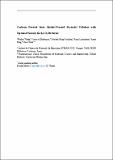Por favor, use este identificador para citar o enlazar a este item:
http://hdl.handle.net/10261/243003COMPARTIR / EXPORTAR:
 SHARE
BASE SHARE
BASE
|
|
| Visualizar otros formatos: MARC | Dublin Core | RDF | ORE | MODS | METS | DIDL | DATACITE | |

| Título: | Carbons derived from alcohol-treated bacterial cellulose with optimal porosity for LieO2 batteries |
Autor: | Wang, Wenhai; Khabazian, Siavash; Roig Sánchez, Soledad; Laromaine, Anna CSIC ORCID; Roig Serra, Anna CSIC ORCID; Tonti, Dino CSIC ORCID | Palabras clave: | Bacterial cellulose Solvent exchange Porous carbons Electrochemical surface area Li–O2 batteries |
Fecha de publicación: | nov-2021 | Editor: | Elsevier | Citación: | Renewable Energy 177: 209-215 (2021) | Resumen: | Porous carbons are important cathode materials for metal-air batteries, but the most usual methods to prepare these porous structures are complex and of high cost. We have prepared porous carbons from bacterial cellulose (BC) hydrogels by a simple water-alcohol solvent exchange before carbonization. Alcohol treatment facilitates looser and more open structures than untreated BC, resulting in porous carbon structures with high surface area, appropriate for electrochemical applications. Used as cathodes in lithium-oxygen batteries, the carbon derived from 1-butanol treated BC has excellent discharge capacity (5.6 mA h cm−2) and good cycle life. This work presents a sustainable, straightforward and fast way to prepare porous carbon materials from BC. | Versión del editor: | http://dx.doi.org/10.1016/j.renene.2021.05.059Get | URI: | http://hdl.handle.net/10261/243003 | ISSN: | 0960-1481 |
| Aparece en las colecciones: | (ICMAB) Artículos |
Ficheros en este ítem:
| Fichero | Descripción | Tamaño | Formato | |
|---|---|---|---|---|
| Wang_RenewEnerg_2021_editorial.pdf | Artículo principal | 1,63 MB | Adobe PDF |  Visualizar/Abrir |
| Wang_RenewEnerg_2021_suppl_editorial.pdf | Información complementaria | 2,18 MB | Adobe PDF |  Visualizar/Abrir |
CORE Recommender
Este item está licenciado bajo una Licencia Creative Commons

